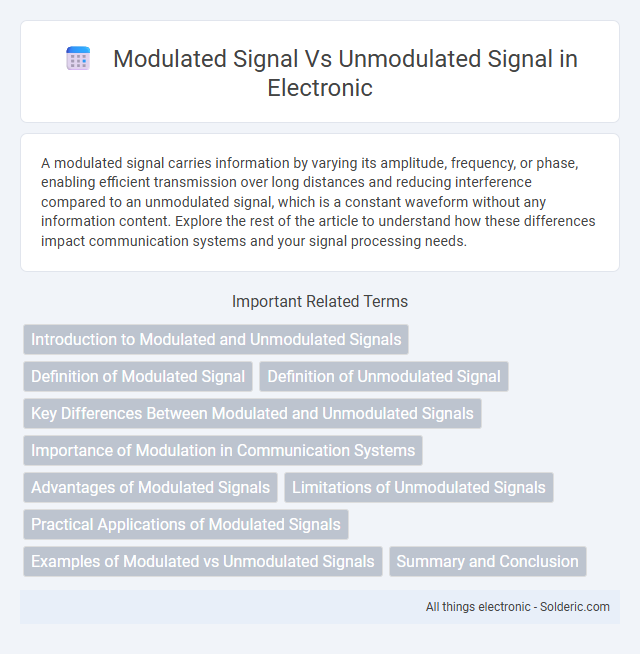A modulated signal carries information by varying its amplitude, frequency, or phase, enabling efficient transmission over long distances and reducing interference compared to an unmodulated signal, which is a constant waveform without any information content. Explore the rest of the article to understand how these differences impact communication systems and your signal processing needs.
Comparison Table
| Feature | Modulated Signal | Unmodulated Signal |
|---|---|---|
| Definition | Signal whose properties (amplitude, frequency, or phase) vary to carry information | Raw carrier signal without information encoding |
| Purpose | Transmit information efficiently over a medium | Serve as a baseline signal or carrier wave |
| Frequency Range | Shifted or varied according to modulation scheme | Fixed carrier frequency |
| Information Content | Encodes data, voice, video, or other signals | No information content |
| Bandwidth | Usually wider due to modulation sidebands | Narrow bandwidth limited to carrier frequency |
| Transmission Efficiency | Higher due to effective use of spectrum and noise resistance | Low, no data transmission |
| Examples | AM, FM, PM, QAM | Unmodulated sine wave carrier |
Introduction to Modulated and Unmodulated Signals
Modulated signals encode information by varying carrier wave properties such as amplitude, frequency, or phase, enabling efficient transmission over communication channels. Unmodulated signals maintain constant amplitude and frequency, representing the original baseband information without alteration. Understanding the differences between modulated and unmodulated signals is fundamental for designing effective wireless and wired communication systems.
Definition of Modulated Signal
A modulated signal is a carrier wave that has been altered in amplitude, frequency, or phase to encode information for transmission, enhancing signal range and resistance to noise. In contrast, an unmodulated signal maintains its original carrier wave form without any information encoding, limiting its effectiveness in communication systems. Modulated signals enable efficient bandwidth utilization and reliable data transfer across various communication channels.
Definition of Unmodulated Signal
An unmodulated signal is a continuous waveform, typically a carrier frequency, that remains constant in amplitude, frequency, or phase without any variations to convey information. In contrast, a modulated signal alters one or more properties of the carrier wave--such as amplitude, frequency, or phase--to encode data for transmission. Unmodulated signals serve as the baseline reference from which modulation techniques derive meaningful communication.
Key Differences Between Modulated and Unmodulated Signals
Modulated signals vary a carrier wave's amplitude, frequency, or phase to encode information, enabling efficient transmission over long distances with reduced interference. Unmodulated signals, also called baseband signals, transmit raw data without altering a carrier wave, limiting range and susceptibility to noise. Your communication system's choice between modulated and unmodulated signals affects data integrity, bandwidth usage, and signal robustness.
Importance of Modulation in Communication Systems
Modulation enables the efficient transmission of signals over long distances by converting baseband signals into higher frequency carriers, allowing multiple signals to share the same channel through frequency, amplitude, or phase variations. Unmodulated signals, confined to low frequencies, suffer from limited range, interference susceptibility, and inability to multiplex, making them less viable for modern communication systems. The use of modulated signals enhances bandwidth utilization, improves signal resilience against noise, and facilitates wireless transmission across diverse media.
Advantages of Modulated Signals
Modulated signals enable efficient transmission over long distances by shifting baseband data to higher frequencies, reducing signal attenuation and interference. They allow multiple signals to coexist through frequency division multiplexing, increasing bandwidth utilization and communication capacity. Enhanced noise immunity in modulated signals improves signal quality and reliability compared to unmodulated signals.
Limitations of Unmodulated Signals
Unmodulated signals suffer from significant limitations, including poor transmission range and susceptibility to noise and interference, which degrade signal quality. They lack the ability to efficiently utilize bandwidth, resulting in higher power consumption and limited data capacity. Your communication system benefits from modulation by overcoming these constraints, enabling reliable long-distance and high-fidelity transmissions.
Practical Applications of Modulated Signals
Modulated signals are essential in wireless communication systems such as radio, television, and cellular networks, where they enable the efficient transmission of information over long distances by varying carrier wave properties like amplitude, frequency, or phase. Unmodulated signals, typically carrier waves, lack information content and serve primarily as reference signals or test signals in practical applications. You rely on modulated signals for clear audio, video, and data transfer in everyday technologies like Wi-Fi, satellite communication, and broadcasting.
Examples of Modulated vs Unmodulated Signals
A modulated signal, such as an AM radio broadcast or a frequency-modulated (FM) audio transmission, carries information by varying its amplitude, frequency, or phase, whereas an unmodulated signal like a continuous wave (CW) or a carrier wave remains constant without information encoding. Your choice between modulated and unmodulated signals depends on the application; for instance, unmodulated signals are used in radar systems for detection purposes, while modulated signals enable communication in television, radio, and cellular networks. Understanding these examples helps clarify how modulation enhances signal utility by embedding data within carrier waves.
Summary and Conclusion
Modulated signals efficiently transmit information over long distances by varying carrier wave properties such as amplitude, frequency, or phase, enhancing signal robustness and bandwidth utilization. Unmodulated signals lack this variability, limiting their transmission range and susceptibility to noise interference. Modulation is essential for effective communication systems, enabling clearer, more reliable signal transfer compared to unmodulated signals.
modulated signal vs unmodulated signal Infographic

 solderic.com
solderic.com